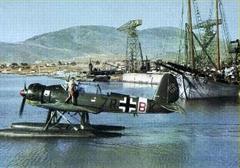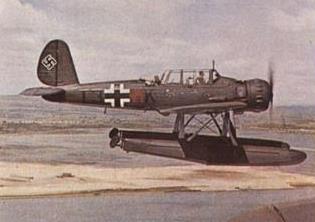In 1933, the Kriegsmarine looked for a standardized shipboard reconnaissance aircraft. After a brief selection period, the Reichsluftfahrtministerium (German Air Ministry, RLM) decided on the Heinkel He 60 biplane. This was one of a line of developments of a basic biplane airframe that appeared as a number of floatplanes, trainers, and fighters. Deliveries started in a matter of months.
By 1935, it was found that the He 60's performance was lacking and the RLM asked Heinkel to design its replacement. The result was the He 114. The first prototype was powered by the Daimler-Benz DB 600 inline engine, but it was clear that supplies of this engine would be limited and the production versions turned to the BMW 132 radial engine instead.
The plane proved to have only slightly better performance than the He 60, and its sea-handling was poor. Rushed modifications resulted in a series of nine prototypes in an attempt to solve some of the problems, but they didn't help much. The Navy gave up, and the planes were eventually sold off to Romania, Spain and Sweden.
In October 1936, the RLM asked for a He 114 replacement. The only stipulations were that it would use the BMW 132, and they wanted prototypes in both twin-float and single-float configurations. Designs were received from Dornier, Gotha, Arado and Focke-Wulf. Heinkel declined to tender, contending that the He 114 could still be made to work.
With the exception of the Arado low-wing monoplane design, all were conventional biplanes. That gave the Arado better performance than any of the others and the RLM ordered four prototypes. The RLM was also rather conservative by nature, so they also ordered two of the Focke-Wulf Fw 62 design as a backup. It quickly became clear that the Arado would work effectively, and only four prototypes of the Fw 62 were built.
The Ar 196 prototypes were all delivered in summer 1937, V1 (which flew in May) and V2 with twin floats as A models, and V3 and V4 on a single float as B models. Both versions demonstrated excellent water handling and there seemed to be little to decide one over the other. Since there was a possibility of the smaller outrigger floats on the B models "digging in", the twin-float A model was ordered into production. A single additional prototype, V5, was produced in November 1938 to test final changes.
10 A-0s were delivered in November and December 1938, with a single 7.92 mm MG 15 machine gun in the rear seat for defense. Five similarly equipped B-0s were also delivered to land-based squadrons. This was followed by 20 A-1 production models starting in June 1939, enough to equip the surface fleet.
Starting in November, production switched to the heavier land-based A-2 model. It added shackles for two 50 kg bombs, two 20 mm MG FF cannons in the wings, and a 7.92 mm MG 17 machine gun in the cowling. The A-4 replaced it in December 1940, strengthening the airframe, adding another radio, and switching props to a VDM model. The apparently mis-numbered A-3, which had additional strengthening of the airframe, replaced the A-4. The final production version was the A-5 from 1943, which changed radios and cockpit instruments, and switched the rear gun to the much-improved MG 81Z.
The Ar 196C was a proposed aerodynamically-refined version. The Ar 196C project was cancelled in 1941.
Operational history
An Ar 196 on board the German cruiser Admiral Hipper
The plane was loved by its pilots, who found it handled well both in the air and on the water. With the loss of the German surface fleet, the A-1s were added to coastal squadrons and continued to fly reconnaissance missions and submarine hunts into late 1944. Two notable operations were the capture of HMS Seal, and the repeated interception of RAF Armstrong-Whitworth Whitley bombers. Although it was no match for a fighter, it was considerably better than its Allied counterparts, and generally considered the best of its class. Owing to its good handling on water, the Finnish Air Force utilized Ar 196s just for transporting and supplying special forces patrols behind enemy lines, landing on small lakes in remote areas. Several fully equipped soldiers were carried in the fuselage.
Arado in Allied hands
The first Arado Ar 196 to fall into allied hands was an example belonging to the German cruiser Admiral Hipper, which was captured in Lyngstad, Eide, by a Norwegian Marinens Flyvebaatfabrikk M.F.11 seaplane of the Trøndelag naval district on 8 April 1940, at the dawn of the Norwegian Campaign. After being towed to Kristiansund by the torpedo boat HNoMS Sild, it was used against its former owners, flying with Norwegian markings. At 03:30 on 18 April, the Arado was evacuated to the UK by a Royal Norwegian Navy Air Service pilot. The plane was shortly thereafter crashed by a British pilot while on transit to the Helensburgh naval air base for testing. At the end of the war, at least one Arado Ar 196 was left at a Norwegian airfield and kept in use as a liaison aircraft by the Royal Norwegian Air Force for a year on the West coast.
Ar 196A-0 - 10 delivered 11.38 - 12.38. Preseries of 10 units. One rear MG 15 and 2 50 kg bomb launchers.
Ar 196A-1 - 20 delivered from 6.39. 1 movable MG 15 in the rear cockpit and 2 SC 50 bombs. 20 units for the Kriegsmarine. Manufactured from November, 1938. Delivered in June, 1939 to the 5. / BFlGr 196 for battleships Admiral Graf Spee, Deutschland, Scharnhorst, Gneisenau, Admiral Scheer, Lützow, Tirpitz, Bismarck, Admiral Hipper and Prinz Eugen.
Ar 196A-2 - delivered from 11.39, first production model with the fixed forward firing armament of 2 20-mm MG FF in the wings and 1 MG 17 + 1 movable MG 15 in the rear cockpit and 2 SC 50 bombs.. 98 reconnaissance seaplanes manufactured from November, 1939 to September, 1940.
Ar 196A-4 - delivered from 12.40, strengthened structure, additional radio (FuG 16Z), air-screw spinner. Catapulting A-3 version built in 24 units from October to December, 1940 to replace the A-1.
Ar 196A-3 - delivered from 3.41. Evolution of the A-2 with new radio equipment and a strengthened structure. Allocated to the KüFlGr 706. 339 units manufactured from October, 1940 to September, 1941 .
Ar 196A-5 - delivered from 3.43, improved radio equipment (FuG 16Z and FuG 25a, later supplanted by FuG 141), the flexibly-mounted MG 15 in the rear cockpit giving place to an MG 81Z (twin 7.9-mm MG 81s) with 2000 rounds.
Ar 196B-0 - 10 delivered 1940-41, single floats
Ar 196C - Project of a aerodynamically-refined version, cancelled in 1941.
| Type |
B Two seat reconnaissance seaplane |
A0/A1 Two seat reconnaissance seaplane |
A2 Two seat reconnaissance seaplane |
A3 Two seat reconnaissance seaplane |
| Engine |
1 BMW 132K with a 3-blade variable pitch prop. dia 3,10 m |
| Dimensions |
Length 11,3 m, height 5,03 m, span 12,44 m, wing area 28,3 m2 |
Length 10,96 m, height 5,0 m, span 12,44 m, wing area 28,3 m2 |
Length 10,96 m, height 5,0 m, span 12,44 m, wing area 28,3 m2 |
Length 10,96 m, height 5,0 m, span 12,44 m, wing area 28,5 m2 |
| Weights |
Empty kg, max. ´flying weight kg. fuel 600 l, oil 27,5 l |
Empty 2335 kg, max. ´flying weight 3100 kg kg. fuel 600 l (2 x300 l), oil 27,5 l |
Empty 2214 kg, max. ´flying weight 3277 kg kg. fuel 600 l (2 x300 l), oil 27,5 l |
Empty 2214 kg, max. ´flying weight 3415 kg kg. fuel 600 l (2 x300 l), oil 56 l |
| Performance |
Max. speed 320 km/h, max. diving speed 450 km/h, cruising speed 280 km/h, landing speed 100 km/h, range km, service ceiling |
Max. speed 320 km/h, max. diving speed 450 km/h, cruising speed 280 km/h, landing speed 100 km/h, range km, service ceiling m, rate of |
Max. speed 320 km/h, max. diving speed 450 km/h, cruising speed 250 km/h, landing speed 104 km/h, range 860 km, service ceiling 5550 m |
Max. speed 320 km/h, max. diving speed 465 km/h, cruising speed 250 km/h, landing speed 104 km/h, range 860 km, service ceiling 6000 m, climb t 1000 m 2,5 min. |
| Armament |
1 7,92 mm MG 15 (525 rounds), 1 7,92 mm MG 17 (500 rounds), 2 50 kg bombs |
1 7,92 mm MG 15 (525 rounds), 2 50 kg bombs |
1 7,92 mm MG 15 (525 rounds), 1 7,92 mm MG 17 (500 rounds),2 20 mm MG FF (2 x 60 rounds), 2 50 kg bombs |
1 7,92 mm MG 15 (525 rounds), 1 7,92 mm MG 17 (500 rounds),2 20 mm MG FF (2 x 60 rounds), 2 50 kg bombs |
| Type |
A-4 Two seat reconnaissance seaplane |
A-5 Two seat reconnaissance seaplane
|
C ( Project)Two seat reconnaissance seaplane |
| Engine |
1 BMW 132K with a 3-blade variable pitch prop. dia 3,10 m |
|
| Dimensions |
Length 10,96 m, height 5,0 m, span 12,44 m, wing area 28,3 m2 |
Length 10,98 m, height 5,0 m, span 12,44 m, wing area 28,5 m2 |
Length 10,96 m, height 5,0 m, span 12,44 m, wing area 28,5 m2 |
| Weights |
Empty 2214 kg, max. ´flying weight 3500 kg, fuel 2 x 400 l, oil 66 l |
Empty 2210 kg, max. ´flying weight 3450 kg, fuel 2 x 300 l, oil 56 l |
Empty 2810 kg, max. ´flying weight 3810 kg, fuel 2 x 625 l, oil ? l
|
| Performance |
Max. speed 320 km/h, max. diving speed 510 km/h, cruising speed 285 km/h, landing speed 110 km/h, range 1270 km, service ceiling 5000 m |
Max. speed 320 km/h, max. diving speed 465 km/h, cruising speed 255 km/h, landing speed 104 km/h, range 1020 km, service ceiling 6000 m , climb to 1000 m 2,3 min. |
Max. speed 320 km/h, max. diving speed ? km/h, cruising speed 190 km/h, landing speed ? km/h, range 1490 km, service ceiling 5260 m
|
| Armament |
1 7,92 mm MG 15 (525 rounds), 1 7,92 mm MG 17 (500 rounds),2 20 mm MG FF (2 x 60 rounds), 2 50 kg bombs
|
2 7,92 mm MG 81Z (2000 rounds), 1 7,92 mm MG 17 (500 rounds),2 20 mm MG FF (2 x 60 rounds), 2 50 kg bombs |
2 7,92 mm MG 81Z (2000 rounds), 1 7,92 mm MG 17 (500 rounds),2 20 mm MG 151/20 (2 x 200 rounds) |


